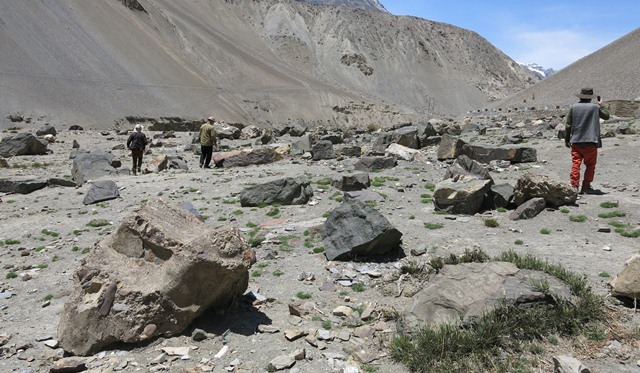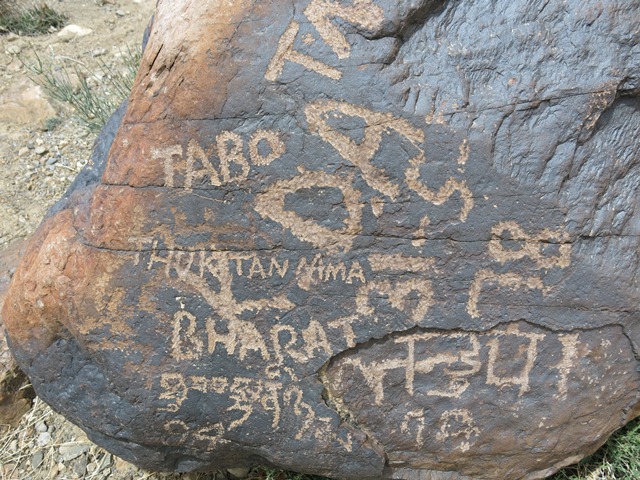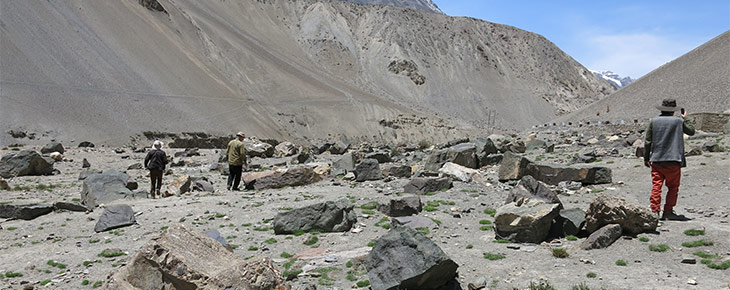
July 2015
John Vincent Bellezza
Flight of the Khyung returns you to a wonderland perched on the western edge of the Tibetan Plateau! This month’s offering is exclusively devoted to the rock art of Spiti, the most graphic and extensive record of its ancient culture. The current issue provides readers with a comprehensive introduction to the rock art of the region. This fascinating view of the early cultural history of Spiti through its pictorial record complements articles in the May and June newsletters.
On the Spiti Antiquities Expedition (May and June of this year), my team and I attempted to document every single ancient carving and painting in the region. Although our searches were exhaustive, there is no question that we missed some rock art in the large areas that had to be canvassed. Still, I think it is fair to say that our coverage was thorough. My team and I contributed to the discovery of two more rock art sites in Spiti. On the expedition, I photographed 90% of the rock art documented, often taking multiple shots to get the best picture possible. By the end of the journey, I had collected some 6000 photographs of Spitian rock art, probably the largest collection of such images in the world.
Upcoming newsletters will present more specialized studies of Spiti’s rock art.
New Books by John Vincent Bellezza
It with much pleasure that I announce the publication of two new volumes on the archaeological monuments of Upper Tibet:
2014. Antiquities of Zhang Zhung: A Comprehensive Inventory of Pre-Buddhist Sites on the Tibetan Upland, Residential Monuments, vol. 1. Miscellaneous Series – 28. Sarnath: Central University of Tibetan Studies.
2014. Antiquities of Zhang Zhung: A Comprehensive Inventory of Pre-Buddhist Sites on the Tibetan Upland, Ceremonial Monuments, vol. 2. Miscellaneous Series – 29. Sarnath: Central University of Tibetan Studies.
Although these books were published in India, no expense was spared in their production. They contain more than 2000 color photographs and 42 color maps. For a synopsis of the work, please go to the “Books” section of this website.
The distributor of books published by the Central University of Tibetan Studies is Biblia Impex India. The books can be ordered on their website: contact@bibliaimpex.com
A Comprehensive Introduction to the Rock Art of Spiti
Geographic setting
Spiti, perched on the western edge of the Tibetan plateau, is home to a rich array of rock art. It is only in the last two years that the extent of this precious resource for understanding the early cultural history of the region has become known. In fact, the lower Spiti valley boasts one of the densest concentrations of petroglyphs (rock carvings) in the entire Tibetan world. In 2015, I documented approximately 1400 boulders with carvings and no less that 6000 individual petroglyphs, extending from the settlement of Sumdo (Sum-mdo) to the village of Poh (sPo).* There are also petroglyphs, pictographs and bas relief carvings of ancient chortens (stupas) in upper Spiti.
Previous studies
The first report of petroglyphs in Spiti was made more than a century ago by Francke (1914: 37), who stated that below the village of Lari there are many rock carvings, particularly those of ibex and swastikas. Francke (ibid.) describes one petroglyph in Lari as having six branches and six roots, which he thought may have been the ‘willow of the world’, one of the pre-Buddhist cosmological symbols of the region. Francke (ibid.) noted a rock art motif that appeared to be the sun and moon. He (ibid., 38) also mentions that in Tabo there are “countless rock carvings”, consisting mostly of ibexes and swastikas that may be of pre-Buddhist origins.
A couple decades later, Tucci (1936: 48) reported that prehistoric figures of humans and ibexes were engraved on big rock faces in Spiti on the side of the trail below Kunzam La. Tucci (ibid.) remarked that these petroglyphs were of the same type as those studied by Francke in Ladakh. The whereabouts of the rock art described by Tucci is unknown today. It appears that modern road construction led to the complete destruction of the site. Tucci (1935: 115, 116; Norbu 2009: 175, 176) also noted petroglyphs of wild goats, anthropomorphic figures with uplifted arms and a tree of a non-Buddhist character on a boulder situated on the south side of the Kunzam La. More recently, Thakur (2001; 2008) and Handa (2001) have studied the rock carvings of Spiti.
Locational characteristics
The twenty-four sites of petroglyphs in lower Spiti (Spi-ti gsham) contain more than 95% of all rock art in the region. Most of these sites are in close proximity to the Spiti river. Only three sites in lower Spiti are situated in tributary valleys. The rock carvings of Spiti were made primarily on individual boulders ranging in size from 50 cm to over 4 m in length. There are just two sites where carvings are located on cliffs. According to Thakur (2008: 28), the boulders are of granite, gneiss and schist, etc. These rocks are strewn across benches, terraces and flats suspended above the Spiti river.
Without exception, all rock carving sites in the main Spiti valley and the one in the mouth of the Gyu valley straddle long-established pathways. Thus, ancient rock art and lines of communication went hand in hand. While some of these locations may have been the focus of hunting expeditions, especially in the winter, it appears they were chosen primarily for their visibility and frequency of usage.
Locational parallels can be drawn with rock art sites in Ladakh. The largest concentration of rock art in Ladakh is found along the Indus river (Bruneau and Bellezza 2013: 21). These sites in the Indus valley have an east-west distributional pattern and occur along an old transportation conduit (ibid., 25), as do sites in lower Spiti. Conversely, the rock art sites in Upper Tibet (sTod and Byang-thang) are not located in major river valleys, but rather in smaller valleys and near lakeshores.
Two of the twenty-four sites of petroglyphs in lower Spiti (Spi-ti gsham) are actually seated in the district of Kinnaur, on the right side of the Spiti valley, but rock art there is closely related to that in Spiti proper. There are just two petroglyphic sites in upper Spiti (Spi-ti stod) consisting of a lone boulder each. Two sites of bas relief carvings of chortens (stupas) have also been discovered in upper Spiti. Additionally, there are four sites with significant red ochre rock art in the upper portion of Spiti. The rock art sites of Spiti (from lowermost to uppermost) are listed below.
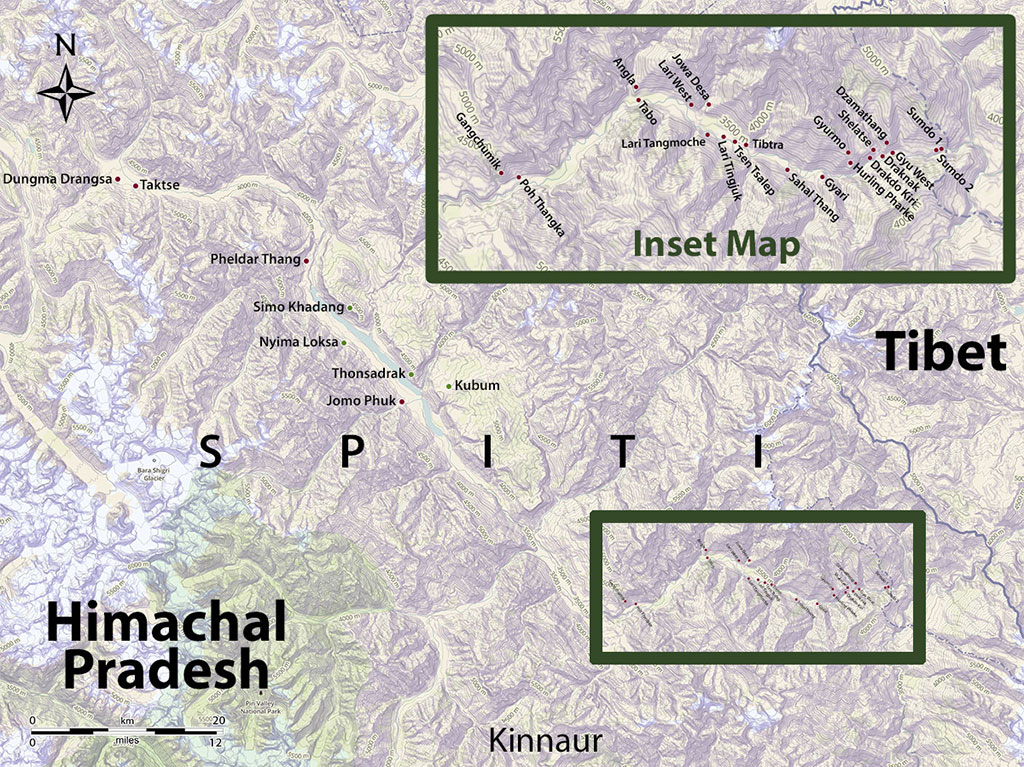
The rock art sites of Spiti: red dot denotes petroglyphs, green dot denotes pictographs. Map by Brian Sebastian and John Vincent Bellezza. Click to enlarge.
Petroglyphs
| Name of Site | Location |
| Sumdo (Sum-mdo) 1 | Cliffs immediately above the main road |
| Sumdo 2 | Giant boulder above the river |
| Dzamathang (rDza-ma-thang) | Shelf above the Gya river |
| Shelatse (Shel-la-rtse) | Old trail between Hurling and Sumdo |
| Hurling Pharke (Hur-gling phar-ke) | Slopes west of the Karti Naullah |
| Gyurmo (Gyur-mo) | Inside the Karti Naullah above Hurling |
| Gyu West (rGyu) | Bench below main road west of Gyu confluence |
| Draknak (Brag-nag) | Slopes east of Hurling |
| Drakdo Kiri (Brag-rdo ki-ri; spelling?) | Benches east of Hurling |
| Gyari (rGya-ri) | Broad slope on east side of Sumra river |
| Sahal Thang (Sa-skal-thang) | Benches on west side of Sumra river |
| Tibtra | Bench near flood damaged bridge east of Lari |
| Tsen Tsalep (rTsan-rtsa leb; spelling?) | Flats near Lari stud farm |
| Lari Tingjuk (La-ri Ting-mjug) | Flats east of Lari |
| Lari Tangmoche (La-ri thang-mo che) | Fields and orchards around Lari |
| Jowa Desa (Jo-ba sdad-sa) | Inside side valley at Lhari |
| Lari West | Benches west of Lari |
| Tabo (Ta-po) | Tabo and environs |
| Angla (dBang-la?) | On slopes and ridge north of Tabo |
| Poh Thangka (sPo thang-kha) | Benches upstream of Poh |
| Gangchumik (sGang-chu mig) | Slopes upstream of Poh on old trail to Dankhar |
| Jomo Phuk (Jo-mo phug) | Cliff and boulders near Jomo Phuk |
| Pheldar Thang (’Phel-dar thang) | Boulder shrine in eponymous flat |
| Dungma Drangsa (mDung-ma brang-sa) | A boulder at the foot of Kunzam La |
| Taktse (sTag-rtse?) | A boulder at the foot of Kunzam La. |
Pictographs
| Name of Site | Location |
| Kubum (sKu-bum) | Old Tengyü monastery |
| Thonsadrak (mThon-sa brag) | Across Spiti river from Rangrik |
| Nyima Loksa (Nyi-ma log-sa phug) | Cave above Sumling |
| Simo Khadang (Srin-mo kha-gdang) | Cave above Chichim |
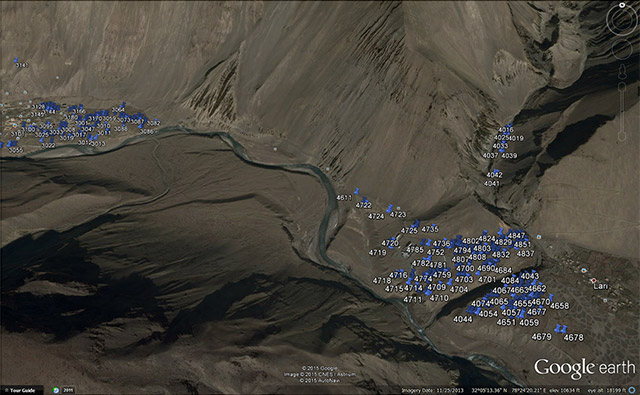
Click the image above to download a Google Earth placemark file with locations of all rock art boulders in Spiti.
File compiled by the Spiti Rock Art and Historical Society.
The contents and their incidence
The rock art of Spiti boasts a wide spectrum of both figurative and non-figurative compositions, consisting of various zoomorphic, anthropomorphic, geometric and symbolic subjects. Animals make up around 70% of the total number of petroglyphs, anthropomorphs constitute approximately 15% of the total, geometric forms 10%, and symbolic subjects and shrines 5%.
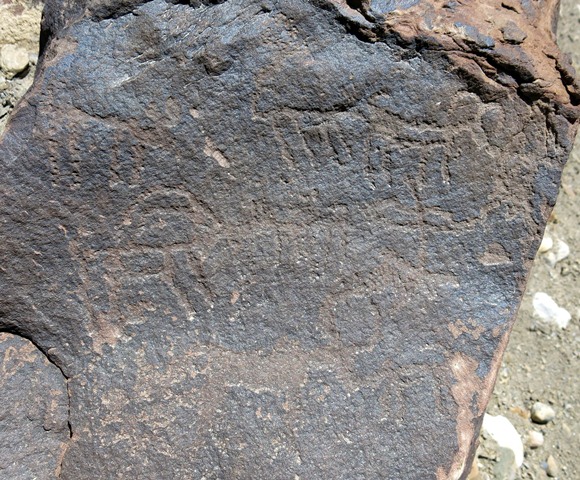
Fig. 2. Ibex, blue sheep and wild yak carvings, Draknak. Protohistoric period.
The most common animals depicted in the petroglyphs of Spiti are wild caprids, which constitute approximately 90% of zoomorphic subjects. The most prevalent caprid portrayed is the blue sheep (Pseudois nayaur; gna’-ba / rna-ba / rnga), followed by the ibex (Capra sibirica; skyin).* The ratio of blue sheep to ibex appears to be at least two to one. In the rock art of Spiti blue sheep are identified by shorter horns that curve in opposite directions on either side of the head. Ibex are identified by one or two horns overarching the body of animals. There are however permutations in the style of horns creating a good deal of ambiguity in certain depictions of these two species. Still, today, the blue sheep is the most common wild ungulate and the ibex the second most common, reflecting their prevalence in the zoomorphic rock art of Spiti.
The ibex is probably the most widespread animal species depicted in the rock art of Eurasia. There are many dozens of studies that cover ibex rock art at some length or another, some of which can be downloaded from the internet for free. For example, the ibex is the most common animal in rock art hunting scenes of northern Pakistan (Hauptman 2007: 24). On ibex in the rock art of Ladakh, see Thsangspa 2014; Thsangspa n.d.; Bruneau 2010; Aas 2009. For ibex rock art in Wakhan: Mock 2011. For ibex in Mongolia: Jacobson and Meacham 2009. On the religious and mythological functions of ibex in the rock art and art more generally of the Near East, consult Avner et al. forthcoming.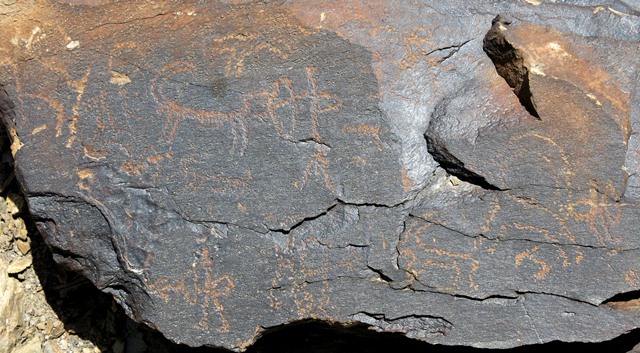
Fig. 3. Hunters on foot with bows and arrows attacking ibex, Braknak. Protohistoric period.
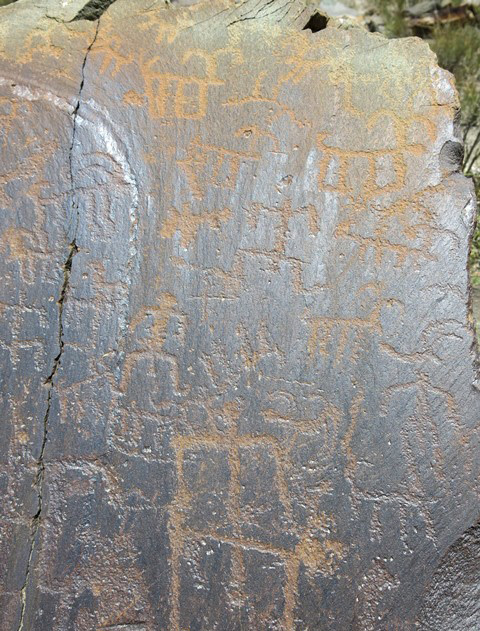
Fig. 4. Ibex, blue sheep and anthropomorphs in a non-hunting context, Gyurmo. Iron Age and Protohistoric period.
In the rock art of Spiti blue sheep and ibex are found as part of hunting and non-hunting compositions. Some caprid petroglyphs may possibly portray markhor (Capra falconeri; rwa-che), however, this species is not reported in contemporary Spiti. The remaining 10% of zoomorphs in Spiti rock art in descending order of frequency are equids (mostly horses), wild yak (’brong), wild carnivores (tigers, snow leopards and wolves), deer (sha-ba), argali sheep (gnyan) and birds.
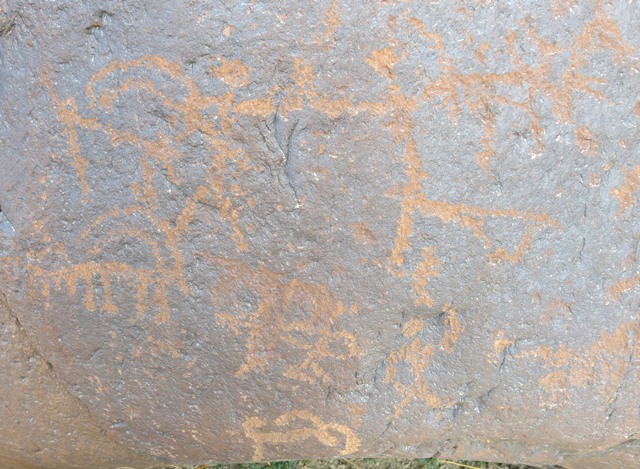
Fig. 5. Stick figures brandishing bows and other anthropomorphic and animal figures, Sahal Thang. Protohistoric period.
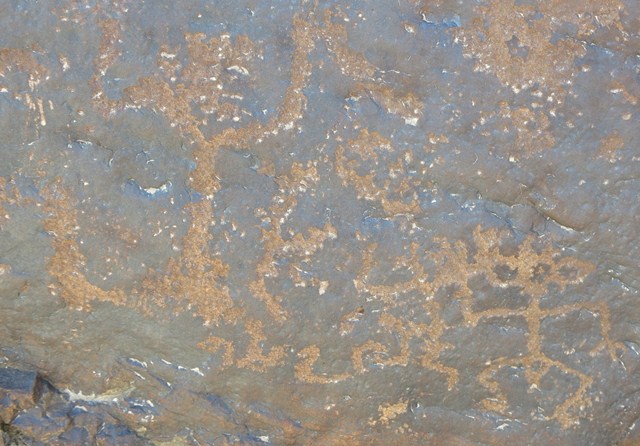
Fig. 6. Dancing figures with Tibetan inscription of same timeframe, Tabo. Early Historic period. The ancient epigraphy of Spiti will be examined in an upcoming newsletter.
The standard anthropomorphic depiction in the rock art of Spiti consists of figures with long, straight, narrow bodies and thin legs and arms. Many of these anthropomorphs are nothing more than stick figures and their heads are usually round. There are two basic types of emblematic figures, one with curved appendages and one with angular appendages. Commonly, anthropomorphs are depicted with male genitalia. Emblematic anthropomorphs are often shown with nothing in their hands, but a substantial minority wields bows and other types of objects. Many anthropomorphs have arms extending downward. This is in contrast to Upper Tibet and Ladakh where the majority of anthropomorphic figures have outstretched or uplifted arms.*
Major works on the rock art in Upper Tibet include Chayet 1994; Chen Zhao Fu 2006; Francfort et al. 1990, 1992; Li Yongxian 2004; Suolang Wangdui (Bsod-nams dbang-’dus) 1994; Bellezza 1997; 2000; 2001; 2002a; 2002b; 2008; Bruneau and Bellezza 2013. On rock art in Ladakh, see some of the above as well as Francke 1902; 1903; 1914; De Terra 1940; Mani 1998; Vernier 2007; Bruneau 2013; 2010; Bruneau and Vernier 2010; Thsangspa; n.d.; 2014.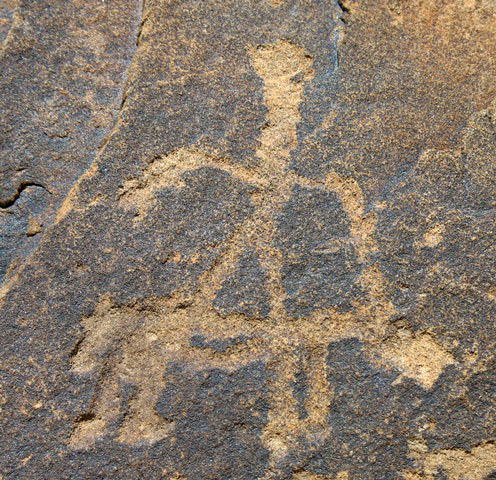
Fig. 7. Figure on horseback, Dzamathang. Protohistoric or Early Historic period.
In contrast to Upper Tibet and Ladakh, martial contests and battle scenes in the rock art of Spiti are rare. Horse riders constitute another category, albeit a small one, of anthropomorphic rock art in Spiti. In Upper Tibet and Ladakh, equestrian arts are much better represented. Spiti is a precipitous mountain region with far fewer level areas than either Ladakh or Upper Tibet. The hunting of blue sheep and ibex was usually carried out in rugged terrain unsuitable for horses. These factors may help to account for the paucity of horse rider rock art in the region.
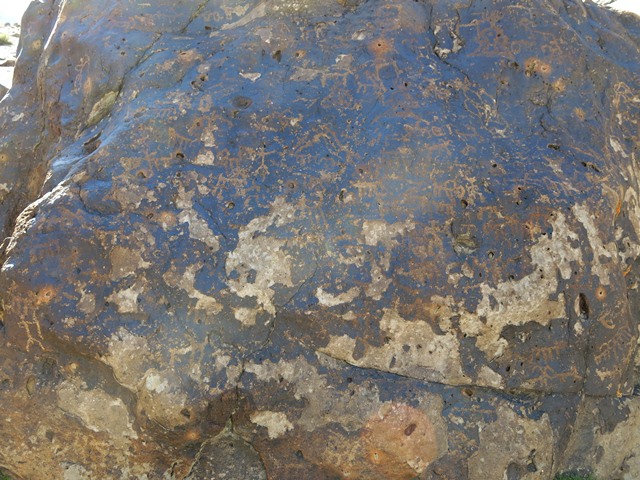
Fig. 8. A large mass of anthropomorphic and zoomorphic figures, Sahal Thang. Protohistoric period.
Large composite scenes are typical of Spitian rock art; they consist of many animals and anthropomorphs with each figure touching the other or nearly so. Lines and more complex geometric subjects are often interspersed among figurative art. These types of complex scenes are full of activity and exuberance, a symphony of figures in movement. Large composite scenes are less common in Upper Tibet and groups of interconnected subjects are very unusual.
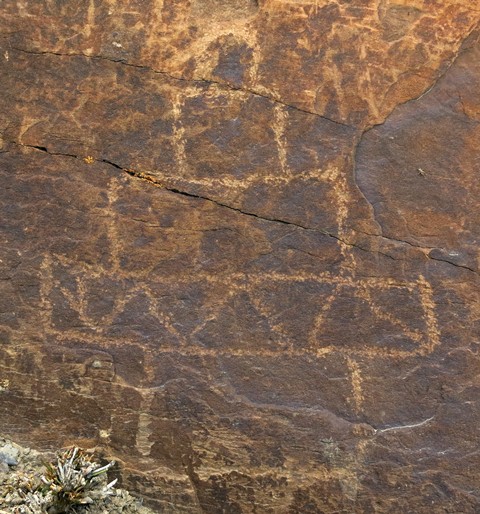
Fig. 9. A rudimentary chorten or some other type of tiered shrine, Gyurmo. Early Historic period.
Elementary stepped shrines and more complex multi-tiered chortens comprise another major category of figurative rock carvings in Spiti.* These types of ceremonial structures have a strong resonance with those in Upper Tibet and Ladakh.
Thakur (2008: 35) connects the origins of “Bon” stupas in Spiti rock art to the piling up of stones and horns on passes or in ravines to appease deities. It is true that tiered shrines (lha-rten / gsas-mkhar), cairns (lab-rtse / la-btsas) and horns in high places (ru-thog) all function as receptacles or tabernacles (rten) for deities.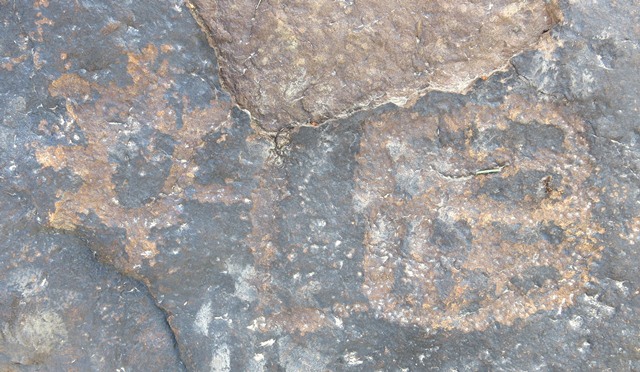
Fig. 10. A simple geometric subject consisting of a square partitioned into twelve sections and sun, Tabo. Protohistoric or Early Historic period.

Fig. 11. A more complex geometric subject consisting of curvilinear and rectilinear motifs, Sahal thang. Iron Age or Protohistoric period.
Non-figurative rock art is dominated by geometric subjects, which can be divided into two major groups: rectilinear and curvilinear. Complex geometric subjects in Spiti are more prevalent than in Upper Tibet or Ladakh. Non-figurative subjects make up around 12% of the total rock art in Ladakh (Bruneau and Bellezza 2013: 31) and considerably less in Upper Tibet, and are largely comprised of simple compositions. In the rock art of Spiti intricate rectilinear and curvilinear designs are quite common.
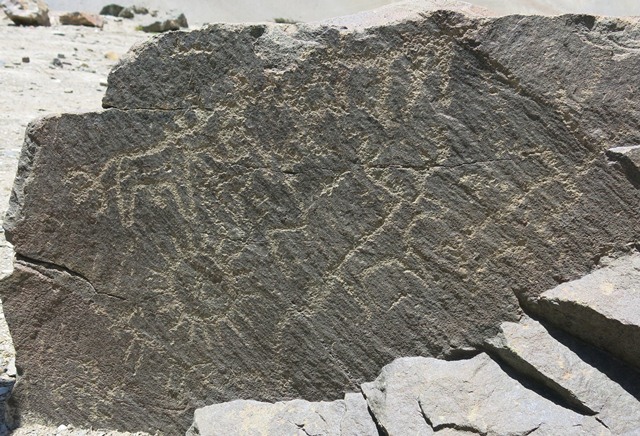
Fig. 12. Sun, swastika, cervid and other wild ungulates taken in direct sunshine, Drakdo Kiri. Protohistoric or Early Historic period. For this rock art also see Chauhan et al. 2014, p. 27.
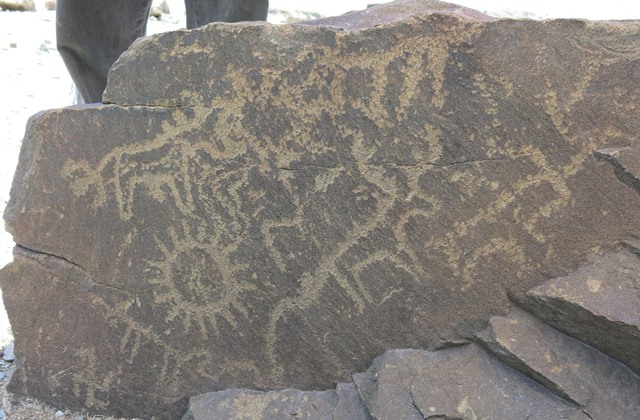
Fig. 13. The same compositions as fig. 10 taken in full shade, illustrating how much the quality of light used in photography affects the appearance of rock art. The shaded figures are more strongly highlighted, but because of the manner in which blue spectrum light is scattered, they appear bleached out.
The repertoire of symbolic representations includes swastikas, sunbursts, crescent moons, trees, circles and dots. As in Upper Tibet and Ladakh, swastikas face in both directions in the rock art of the pre-7th century CE. It must be acknowledged that some rock art in this category may have had a dual function as actual facsimiles of the things shown as well as encapsulating mythological, ideological, mystical and other forms of abstract cultural information.
As in Upper Tibet and Ladakh, there is no irrefutable evidence for the portrayal of domestic animals, pastoralism, encampments and houses, topographical features, or the sky and earth in the rock art of Spiti. We might assume that the rock surface itself was perceived of as simulating the physical environment and that figures created on these surfaces were implicit acknowledgement of the surroundings.
The pictographs of Spiti are mainly distributed in the upper part of the region. There is inconclusive evidence for a few red ochre pictographs in Sumdo in lower Spiti but these are hardly significant. There are four main sites of pictographs in upper Spiti. Several faint ochre applications are also found in the village of Tashigang. Three of the four main sites are in high, out-of-the-way places; therefore, they have very different locational traits than the petroglyphs of lower Spiti. A fourth and less extensive pictographic site is located near the banks of the Spiti river; its contents are similar to other sites in upper Spiti.
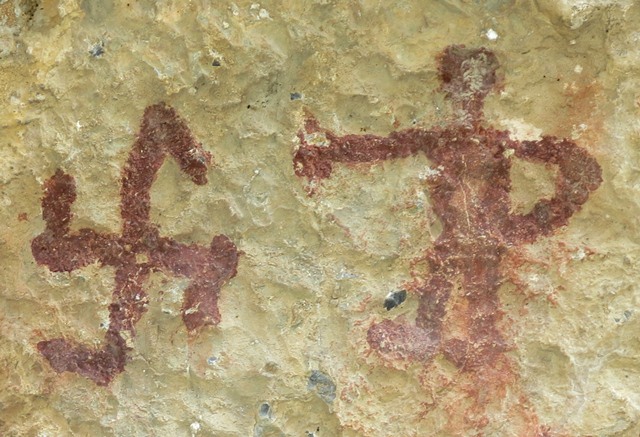
Fig. 14. Anthropomorph and swastika, Nyima Loksa Phuk. Protohistoric period.
In the assemblage of pictographs there is no hunting and almost no animals represented; instead anthropomorphs and symbolic compositions predominate. The anthropomorphs are shown in what appear to be provocative or highly demonstrative poses. The ensemble of symbols includes swastikas, sunbursts, crescent moons, circles and trees.
Techniques of execution
The rock art of Spiti exhibits a fairly narrow variety of techniques used in production. It appears that both stone and metal tools may have been utilized to make petroglyphs. The two common methods of manufacture were to strike or bruise rock surfaces in order to produce lines that compose figures. The individual tool marks on the stone surface can be seen in some petroglyphs. In more highly eroded examples the individual marks on the rock are no longer discernable. The thorough pecking, chipping (striking techniques), grinding or cutting (bruising techniques) of rock surfaces also had the effect of effacing individual tool marks. The depth of penetration of the rock veneer varies considerably. Older art tends to be more deeply abraded or engraved with more of the stone surface removed. Rock art that appears to be of a later date usually has a shallower penetration, rougher lines and less adept modeling.
There are many anthropomorphic and zoomorphic subjects in Spiti where single lines were used to depict the body and legs. These are so-called stick figures. More developed animal figures are shown frequently in outline, but silhouetted varieties created by the removal of the entire surface of the stone from figures also occur. In some early rock art revealing Upper Tibetan influences, the abrasion and engraving of stone surfaces was executed more finely, indicating alternative techniques of execution. Some ceremonial structures of the Vestigial period in Spiti were adeptly rendered with metal cutting tools.*
Thakur (ibid., 31; 2008: 29) says that quite probably the uneven parts of rock surfaces were smoothed with tools to prepare the surface for carving. During my recent expedition to Spiti no evidence was found to suggest that this was the case with petroglyphs (although rock surfaces are sometimes prepared for Buddhist bas relief carvings). Carvers of petroglyphs in Spiti and other places in the Tibetan world usually left the darkened veneer around carvings intact in order to highlight their work.As a rule, a planar perspective was utilized in Spitian rock art, simulating the viewing of figures head on or in profile. Many petroglyphs of Spiti were not as finely executed as certain examples from adjoining areas of the Tibetan plateau, lending them a stiffer or cruder appearance. Finely engraved lines and careful finishing of the edges of figures are not observed. Also, there are few fine anatomical details depicted such as eyes, ears, hooves and furrows of horns. Despite the elementary techniques of execution, some Spitian petroglyphs, especially of the earlier periods, attain a fairly high level of technical and esthetic proficiency.
The pictographic art of Spiti was created using red ochre (oxides of iron). It was executed to fairly high technical and esthetic high standards and is reminiscent technically, stylistically and thematically to pictographs of Ruthok, Shentsa and Nam Tsho in Upper Tibet. Presumably, pictographs were created by applying ochre to stone surfaces with a stick or brush. Figures are both outlined and silhouetted.
Chronology
A calibrated chronology of rock art in Spiti is not yet feasible due to well-known limitations in the scientific techniques used to directly date rock art. The best that can be offered is a relative chronology based on collateral forms of evidence. Briefly, this evidence includes cultural historical analysis, stylistic and thematic categorization, application of collateral archaeological data, gauging environmental changes, examination of techniques of production and placement of superimpositions, and assessment of erosion and re-patination of petroglyphs and browning and ablation of pictographs.
A chronology assembled through such informed means may afford reasonable accuracy in determining the age of rock art compositions vis-à-vis one another. It is still far from foolproof, however, as a number of factors can make rock art seem older or newer than it really is. These include various geochemical factors, lithological conditions, mircoenvironmental forces, and subsequent manipulation of rock art.*
Thakur (2001: 31, 33) divides the petroglyphs of Spiti into three phases based on style, but he is quite vague on the details of such a chronology. Handa (2001: 254, 255), using thematic and stylistic considerations, also divides this rock art into three phases: Phase 1 – totemic primitivism with swastika and ibex as the main motif and with the sun and yoni, probably as part of a fertility cult; Phase 2 – ibexes and stylized anthropomorphs, which may represent a stage of culture when the birth of a child was a cause of thanksgiving; Phase 3 – panthers and horse-riding, which occurred when animals may have been tamed and domesticated and a nomadic system developed. However, I see no basis for the chronological system proposed by Handa. Ibexes, stylized anthropomorphs, felines and suns occur in all phases of Spitian rock art. Horse riders also extend through most phases of it. Handa’s position (ibid., 256) that the rock art of Spiti dates to pre-Buddhist or pre-Kushana times, disregards that of more recent production. The chronological notions of Thakur and Handa underline the danger of relying on graphic evidence alone to assemble a chronology, neglecting the physical state of rock carvings.It must also be kept in mind that relative age is different than absolute age. It is only possible to gain an estimate of absolute age by assigning chronological values to a relative chronology. Relying upon collateral means to date rock art always involves a certain degree of arbitrariness. To reduce the chances of gross error, the subjective assignment of chronological values to rock art should be made in the broadest terms feasible.
I have spent years developing a chronological framework for rock art in Upper Tibet that seems to best capture its age (see my various print publications for details). As the rock art of Spiti is comparable thematically, environmentally and culturally to Upper Tibet variants, a similar chronological system is ideally suited to it. Yet, one must always keep in mind that suppositions concerning the age of rock art not subject to chronometric verification amount to informed opinion. The chronology provided here therefore must be seen as provisional and open to modification should new data determine that it is necessary.
A provisional chronology for the rock art of Spiti is as follows:
I. Prehistoric epoch
- Early Iron Age (circa 900–500 BCE)
- Iron Age (circa 500–100 BCE)
- Protohistoric period (100 BCE to 630 CE)
II. Historic Epoch
- Early Historic period (630–1000 CE)
- Vestigial period (1000–1300 CE)
- Later Historic period (post-1300 CE)
Chronological questions concerning Spiti’s rock art will be examined more closely in the months to come.
A few theoretical considerations
A few words on what constitutes the cultural character of rock art and how this might be ascertained are in order here. There are of course economic, political and environmental forces that mold human creations such as rock art, but for the moment let us leave these aside. We can take it as axiomatic that rock art is the product of specific individuals or groups in specific times and places, and that these individuals or groups possessed culture and language. In the same way that our own cultures and languages color activities and fabrications, so did they affect the creators of rock art. A single work of art, symbolism or technology may be entirely anomalous, bearing little or no relation to the culture of its maker(s). However, an entire class of the same, such as Western Classical music, Indian tridents or Japanese chopsticks, tends to embody the customs, traditions, mythology, religion, social values, collective aspirations and historical awareness of its makers and users. The same holds true for a body of rock art: taken as a whole over the entire area of distribution, it is a cultural elaboration.*
There are indeed unique and iconic subjects and motifs in rock art that operate as indicators of a culture or group of cultures. Nevertheless, it is the relationship between individual subjects and motifs in recurring patterns over their entire area of occurrence that best signify systemic cultural activity. The blueprint of forms relative to one another and their sets of thematic and stylistic traits act as the basis for the determination of an archaeological culture, as defined by rock art. The concert of like rock art can be an index or manifestation of a well defined and stable culture over a small area, a more dynamic culture spread over a wide region, a clash of cultures, a culture in transition, a hybrid culture, or other kinds of cultural dynamics, but in every case it reflects a cultural identity of sorts. A consistent cultural identity in rock art, as determined through its attributes and esthetics, can be further defined through the study of the techniques of manufacture, as well as through the political affiliations, economic activities and environmental imperatives that influenced its creation.
Applying the criteria outlined above to assess Spiti’s rock art demonstrates that it is an integral cultural production, the territorial extent of which corresponds closely to the region itself. The nature of its petroglyphic and pictographic compositions, subjects and motifs, the relationships of these to one another, their frequencies of occurrence, as well as the stylistic repertoire and techniques used in their creation, define this culturally distinctive body of rock art. There are extraneous cultural influences observable in the Spiti rock art record as well. These originated in Upper Tibet and to a lesser extent in Ladakh. Specific examples of affinities between these three regions are furnished in this article and next month’s newsletter is dedicated entirely to them.
Those working on rock art worldwide have devised all manner of methods to divine its unvoiced functions and meanings. These approaches include a reading of semiotics and semantics, historical determinism, cognitive perspectives, accessing a universal language of perception and mentation, artistic formalism, among many others.
It is my position that the meaning, purpose or significance of rock art in Greater Tibet is usually knowable in general terms only. There might be exceptions, as when an accompanying inscription, contemporaneous written source or living tradition of painting or carving reveals the significance of an individual piece or class of rock art. Usually this kind of direct evidence is unavailable, however, forcing the use of lesser methods of interpretation. The most optimal combination of which marshals literary, epigraphic, archaeological and ethnographic evidence to associate personalities, objects, activities, ideologies, myths, narratives and symbols contained therein with rock art. These associations can be harnessed to formulate hypotheses concerning the function and identity of rock art.
Nevertheless, the specificity of the literary and ethnographic records does not easily reconcile itself to the contents of rock art, which remains a silent testament to certain aspects of it. Comparisons drawn with archaeological and epigraphic materials also cannot often pinpoint functions of rock art. Hypotheses derived from associative data of these kinds are of varying and difficult-to-assess validity, and frequently more than one may seem plausible in explaining a particular piece of rock art. Therefore, associative data are best wielded as nonexclusive indicators of the cultural and historical complexion of rock art. In the Tibetan cultural world, rock art tends to underline the antiquity of certain literary and ethnographic materials but in non-specific ways.
General cultural and historical observations
Hunting scenes or those suggestive of the hunt abound in Spitian rock carvings. Figures brandishing bows are found in close proximity to wild ungulates, but in an association that sometimes seem more symbiotic than adversarial. Graphic hunting compositions featuring archers directly aiming at and killing prey are less common in Spiti than in Upper Tibet. Except where there is palpable Upper Tibetan influence, animals are not shown impaled by projectiles.
Ethnographic research I have carried out in the Changthang indicates that hunting was not merely an economic activity to furnish meat, but one closely connected to religious beliefs concerning the pantheon of local spirits and the manner in which they are propitiated.* A sacred dimension is incorporated in the hunting traditions of many different peoples worldwide.† Similarly, hunting may have had mythic, ritual and ceremonial overtones for ancient Spitians.
In traditional hunting rituals of propitiation carried out in the Changthang (Byang-thang), the flesh of a large male blue sheep (in the venatic cant called rgya-’dan) has good fortune-bestowing properties (Bellezza 2008: 462 [n. 345]). There is also a term for the hunting of deer and blue sheep in the Old Tibetan language (sha dang rngas shor / shord / bshor). For a review of historical, economic and technical aspects of hunting antelope in the Changthang, see Huber 2005. On the terminology of hunting in Old Tibetan documents and its historical and cross-cultural context, see Dotson 2013. For example, Jettmar (1988: 87) reports that among the Kalash of Chitral hunting ibex and markhor is considered a sacred activity. According to Olivieri (2011: 43 [n. 15]), in the rock art of Swat the ibex is an iconic figure, which may include the manifestation of a mountain deity, and its hunting was a ritualized activity. On sacred aspects of ibex hunting among the Dards of Ladakh, see Vohra 1989.Aside from their function as the quarry of hunters, blue sheep and ibex have cultic, mythic, ritual and symbolic status in the Tibetan cultural world, as illustrated by archaeological, textual and ethnographic sources. The diverse roles blue sheep and ibex in the rock art of Spiti are reflected in their close proximity to anthropomorphs in various configurations. In Spitian rock art, blue sheep and ibex are often presented alone in portraits as well as in large composite scenes as companions of human figures. The occurrence of these wild ungulates in non-hunting contexts demonstrates how ingrained they were in the local culture from the Iron Age through the Early Historic period. This ancient presence is still reflected in the sacred roles of blue sheep and ibex in contemporary Greater Western Tibet.
The prevalence of blue sheep in the rock carvings of Spiti says much about eco-cultural dynamics of the region in early times (pre-10th century CE). We might call the ancient culture of Spiti a blue sheep culture, one in which this species played a key role in the economic, social and religious life of her people.* Using the same benchmark, ancient Upper Tibet can be referred to as a wild yak culture and Ladakh as a ibex culture, the predominant wild ungulates in those regions. Wild yak rock art makes up more than 40% of all zoomorphic compositions in Upper Tibet and the ibex 47% in Ladakh (Bruneau and Bellezza 2013: 14, 26).
A class of copper alloy figurines of diminutive size in the form of ibex and blue sheep are known in Tibet. Many of these ancient objects are reported to have been unearthed in western Tibet. They appear to have had a talismanic function and some have molded attachment loops, indicating that they were designed to be worn.* Blue sheep also appear to be engraved on a golden death mask recently discovered in Guge, western Tibet.†
For ibex figurines, see Bellezza 1998, p. 60 (fig. 60); John 2006, p. 131 (fig. J-292). Ibex motifs are common in ancient north Inner Asian bronze objects (see Bunker 2002). See Bellezza 2013, p. 157 (n. 259). For an image of the engraved golden death mask, see November 2013 Flight of the Khyung.In Tibetan ritual literature, blue sheep and ibex and their body parts have a wide range of religious functions. The brief review that follows furnishes an incomplete but telling survey of these functions. One Yungdrung Bon ritual text of significant age describes the archetypal tools given to the great mountain god Nyenchen Thanglha (gNyan-chen thang-lha) by his divine grandfather, which includes a bomb (tso) in the form of a blue sheep horn (Bellezza 2005: 179). In Yungdrung Bon ritual literature, the blue sheep horn (rna-ru) is one of the weapons wielded by the chief god of Zhang Zhung, Gekhö (Ge-khod), and the Zhang zhung sage Tonggyung Thuchen (Tong-rgyung mthu-chen) is customarily depicted holding a blue sheep horn with an issuing flame. Yungdrung Bon texts describing the ritual constructs for Gekhö state that his body receptacle is a pair of golden horns of the blue sheep (Bellezza 2008: 256, 258, 322). In another ritual text for the god Gekhö, one of nine divine brothers, Thotho Yampa Thuwoche (Tho-tho yam-pa mthu-bo che), rides on a crystal blue sheep (ibid., 317, 318).
The Yungdrung Bon history of the oral transmission of an esoteric mind training tradition (Bon ma nub pa’i gtan tshigs) records that the Zhang Zhung saint Nangzher Löpo (sNang-bzher lod-po) manifested on an island in Lake Darok Tsho (Da-rog mtsho) from a blue sheep horn of white crystal (Bellezza 1999: 80). In the Old Tibetan ritual text Rnel drĭ ’dul ba’i thabs sogs, a sacrificial blue sheep lamb (rne’u) assists the dead in reaching the celestial afterlife (Bellezza 2013: 158). In this same text, the skin of a blue sheep is used as an apotropaic instrument to free souls enthralled by infernal demons (ibid., 152).
In the Old Tibetan funerary ritual document designated Pt 1134, an ibex named Lord Male Ibex Surmounting Horns (sKyin-po ru-thog rje) acts as an emissary to bring a sacred vulture needed to complete the funeral of a suicide victim (Bellezza 2008: 529; 2010: 41). In a rare illuminated manuscript, written circa the 11th century CE, ibexes aid the dead in reaching the ancestral paradise (Bellezza 2013: 49, 50). A comparable psychopomp function is ascribed to the ibex in the Old Tibetan text Rnel drĭ ’dul ba’i thabs sogs (ibid., 122).
According to Francke (1914: 105), the ibex was a symbol of fertility in pre-Buddhist Ladakh, occupying a role comparable to the ram in Lahul. In Spiti and other regions of Greater Western Tibet, ibex and blue sheep horns are customarily installed on shrines for local protective deities known as lhatho (lha-tho) and lhatsuk (lha-gtsug). The horns function as offerings (mchod-’bul) to and receptacles (rten) for these territorial and ancestral spirits.* To celebrate births in Ladakh, ibexes are fashioned from dough (ibid.). Similarly, Francke believed that ibex carvings in Ladakh represented thanksgiving offerings for the birth of children (ibid.). Pirie (2008: 178) describes a Ladakh ritual commemorating the dead held at the end of the lunar year, in which ibexes made of dough are offered on a rocky outcrop. The carving of ibexes on rocks continues to the present day for the Brokpa (’Brog-pa; Minaro) of lower Ladakh, which are made in gratitude for a successful hunt and in exchange for the animal’s life (Peissel 1984: 85–87). During fertility rites (Gotsi) and sowing rites (Chogtsi khis) in Lahul images of ibex are sculptured from butter (Bellezza 1997: 70 [n. 28]). In the Changthang woman’s sashes are woven with blue sheep and other animals as apotropaic and good luck symbols (Bellezza 2001: 197).†
For a Yungdrung Bon ritual describing the use of a blue sheep horn containing esoteric ingredients as the secret receptacle for the Zhang Zhung god Gekhö, see Bellezza 2005, pp. 443, 444. In the Karakorum and Hindu Kush, ibex also have multifarious functions. For example, in Hunza, in northern Pakistan (the Bru-sha of Tibetan literature), folktales speak of the horns of the ibex touching the heavens while its hoofs are planted on the ground, thus linking it to the realm of people and celestial beings (Bellezza 1997: 70 [n. 28]). In Chitral, among the Kho of the Turcko valley, talismanic rings are made from ibex horns, and the Kalash make auspicious drawings of ibex at the New Year festival of Chumust to help insure a prosperous year (ibid.). Among Shina-speaking Dards, it is believed that fairies take the form of ibexes and markhors to assist hunters (Vohra 1989: 39). As of the 1980s, ibex were still being carved for cultic hunting purposes by the people of Hunza and shrines topped by ibex horns in high valleys.Human figures that can be positively identified as female in the rock art of Spiti are rare. This seems to indicate that the creation of petroglyphs in the region was largely the domain of males. The same observation can be made of Upper Tibetan rock art: it mostly revolves around activities typically conducted by males. The standard anthropomorphs of Spiti often have their arms pointing towards the ground. This form of depiction is not as common in other parts of Greater Western Tibet. The customary portrayal of arms (and hands where shown) gesturing downward may possibly allude to a chthonic component in the symbolic or ideological information intended to be conveyed by this rock art.
The nature of the Spitian pictographs combined with their remote locations indicates that this rock art was produced within a cult setting. There is nothing patently economic about them. The khyung and another bird and anthropomorphs in close association with one another enhance the cultic dimension of the pictographs. The repertoire of symbols (swastika, sun, moon, tree, etc.) selected in the pictographic art of Spiti mirrors ritual and mythological constructs described in Yungdrung Bon literature. It also draws this pictographic art into close cultural and religious correspondence to the rock art of Upper Tibet and Ladakh.
The identification and significance of geometric rock art in Spiti is enigmatic. In the absence of strong cultural indications, the large variety of geometric subjects encourages an inclusive view of their possible functions as both ideograms and pictograms. The lexicon of geometric subjects potentially includes magical diagrams, cosmographs, emblems or signatures of individuals, clans or bands, sacred mental and visionary processes, and perhaps even figurative functions such as the depiction of encampments, labyrinths, or pathways and trajectories in the natural world.*
Thakur (2008: 30, 32, 35) holds that geometric subjects in the rock art of Spiti are kinds of magical symbols that can probably be linked to the deu (lde’u), symbols, riddles and sacred speech of the Yungdrung Bon tradition. In a broad sense he may be correct, but it remains difficult to correlate a religious tradition of the post-10th century CE with older (some much older) geometric designs in rock art, particularly when there are few other clues to go on. If the geometric representations of Spiti are indeed part of a well-known Bon religious tradition, they should also be found in Upper Tibet, but for the most part they are not. One of the oldest Tibetan textual references to deu is as the professional title of a kind of priest (lde’u-gshen) named Munbu (rMun-bu), who is recorded in Pt 1134 as one of three priests conducting a funeral for a prominent warrior (Bellezza 2013: 145 [n. 220]).The rock art tableau of Spiti is noteworthy for its coherence through all periods of its creation (early Iron Age to Vestigial period; circa 800 BCE to 1300 CE). The same types of wild herbivores and anthropomorphs in matching portrayals epitomize this rock art. There is much constancy in nonfigurative art as well, with analogous geometric and symbolic forms represented throughout much of the rock art record. This also holds true for portrayals of tiered shrines: they transcend time to find a place in Spitian rock art of most periods. Styles and techniques of execution changed over time but not greatly so, but the subject matter remained more or less the same.
This kind of homogeneity in the rock art record is consonant with cultural continuity over a long period of time. That is not to say that the cultural development of Spiti was static in ancient times; surely there was scope for cultural and technological innovations or borrowings over the long arc of time. Rather, the rock art record indicates that expressions in the realm of esthetics, symbolism, cult and the economy remained remarkably coherent. This is in keeping with a culture that did not experience serious disruptions to its intellectual and spiritual life. We might also infer from the rock art record that there was not a complete demographic replacement of the pre-Buddhist population in Spiti.*
Similarly, as regards the rock art of Mustang, Pohle (2000: 389–394) observes that it was created by a long-settled and unified cultural-base, as evidenced by variable weathering and patination, a diversity of styles and motifs, different techniques of production, and superimposition. Pohle (ibid.) theorizes that this culture spoke Se-skad and had possible links to Zhang Zhung. Although taken as a whole, the rock art tableaux of Spiti and Mustang are different from one another, they share locations adjacent to Upper Tibet, a hunting culture revolving around wild caprids, a relatively high percentage of geometric subjects, and a comparable repertoire of symbolic motifs.The general impression gained from the rock art of Spiti is that her inhabitants were less overtly bellicose than neighbors to the north and east. The large composite compositions so popular in Spitian rock art seem to embody a tribal foundation, one with close religious links to the animals they hunted. That anthropomorphs with arms pointing down intimate the existence of a chthonic component in the mytho-ritual fabric of ancient Spiti is reinforced by a lack of avian art. With rare exception, avian art in Spiti only occurs where there are evident Upper Tibetan and Ladakhi influences.
Cultural, technological and demographic differences between Spiti on one side and Ladakh and Upper Tibet on the other are also indicated by the monumental portion of the archaeological record. Upper Tibet in particular was home to an extensive network of citadels, temples and necropolises in the Iron Age (600–100 BCE), Protohistoric period (100 BCE to 630 CE) and Early Historic period (630–1000 CE). Pre-Buddhist monuments of considerable size and complexity are also known in lower and central Ladakh, although most examples appear to have been destroyed or redeveloped, as the region has remained relatively densely populated. In Spiti not one large architectural complex predating the 10th century CE has been identified (many tombs have been documented but these have minimal superstructures).
The lack of large-scale ancient monuments in Spiti suggests that it was something of a cultural backwater, a valley largely removed from major ideological and technological developments unfolding around it on the Tibetan plateau. This impression is strengthened by Spitian rock art, most of which is elementary in form and execution. While there are to be sure graceful compositions, ornate, highly embellished depictions are uncommon. Unlike Ladakh, there are very few fancy facsimiles of tiered shrines and chortens. Detailed zoomorphic and anthropomorphic representations are also hardly met with. As observed by Thakur (2008: 35), the rock art of Spiti is simply not as sophisticated as some of that of Central Asia or Indus Kohistan. The same kind of comparison can be made with Ladakh and Upper Tibet.
Spiti’s apparent insulation from cosmopolitan trends affecting other parts of the Tibetan plateau is underscored by its limited range of trans-regional and trans-cultural rock art. For example, there is a conspicuous absence of mascoids and chariots.* These rock art subjects are commonly associated with the Bronze Age by scholars (some of this art in Upper Tibet is of a later date). The paucity of ‘animal style’ rock art of the Iron Age and Protohistoric period in Spiti also paints a picture of a land mostly cut off from the wider cultural and technological forces besetting other parts of the Tibetan plateau and beyond.†
Thakur (2008: 30, 31) claims that a flower-like motif in close proximity to Tibetan inscriptions in Tabo is reminiscent of mascoids of the Changthang, Ladakh, Chilas and Siberia. However, I see no resemblance, the flower dating to a much later period than mascoid rock art. Thakur (2008: 30 31 [fig. 9]), speaking about a now destroyed boulder in Tabo, attempts to link stick figure animals that appeared on it to the ‘animal style’ of the steppes. However, there is no similitude of this rock art to that related to the Saka-Scythian cultures, and which occurs in Mongolia, southern Siberia, Xinjiang, northern Pakistan, Ladakh and Upper Tibet, etc. during the Iron Age.A less complex cultural and socioeconomic order is also seen in the restricted compositional variety of the Spitian rock art record. The subject matter of the rock art tableau of Upper Tibet and especially that of Ladakh is more diverse, which is indicative of a variety of extraneous vectors of cultural influence and transformation. Along with this cultural richness, a confluence of different demic streams is likely to have enriched Ladakh over the course of its rock art making epoch.
It is not clear what the economic underpinnings of the society that created rock art in Spiti were. Thakur (2008: 35) states that it was a nomadic society, but he offers no evidence to back up his opinion. First of all, we must consider the possibility that the subsistence economy of the Spitians changed significantly between the Iron Age and Early Historic period. Wild ungulate hunting remained prevalent in all phases of Spiti rock art, but it is uncertain if this depicts a venatic-based economy or more specialized activities.
As we shall see in the months to come, nearly every tomb discovered in Spiti is situated at the periphery of or what was once the periphery of a village. These tombs are full of ceramic vessels. This would seem to indicate that a sedentary agrarian way of life was already in place by the middle or late first millennium BCE, the dates of comparable tombs in Kinnaur and Guge (Nautiyal et al. 2014; Bellezza 2008: 110–115). Evidence gathered so far indicates that barley agriculture on the Tibetan plateau was possibly introduced in the middle of the second millennium BCE (see February 2015 Flight of the Khyung). Thus, the making of at least some rock art was probably the pursuit of agriculturalists, those engaged in ceremonial or cult behaviors mainly tied to the mythology and ritualism of wild animals.
Thakur (2001: 30, 31, 33) characterizes the rock art of Spiti as belonging to a “Bonpo ritualistic system”, which he defines as a non-Buddhist tradition of a “totemistic cult associated with autochthonous beliefs”. Thakur also states (2008: 33) that the petroglyphs of Spiti were carved by followers of the “Bonpo faith” prior to annexation of Zhang Zhung by the Tibetan empire. In a broadly defined sense he is not incorrect in his attributions. However, as pointed out in an article on the early cultural history of Spiti that appeared in the last two issues of Flight of the Khyung, there is little evidence for a monolithic Bon religion in Greater Western Tibet in prehistoric times. From a reading of the textual, archaeological and ethnographic evidence, it appears that there was a proliferation of archaic religious customs, traditions, beliefs and lineages in this vast and varied territory. Hence, the term bon is best applied in a generic sense, as denoting a wide spectrum of ancient religious and cultural phenomena.
There has also been some speculation among scholars that counterclockwise swastikas and other images on rocks and in caves in Spiti appear to be remnants of the Zhang Zhung kingdom. It must be observed however that rock art in Spiti reveals little about the prehistoric political associations of the region. That is not to say Spiti was not part of a Zhang Zhung polity, but that the contents of its rock art do not necessarily signal this.
In his synopsis of bon, Laxman Thakur presents a rather garbled version of the historical facts. I will not critique his presentation except to refute his allegation (2008: 28) that no written sources about “Bon” written before 10th century have been identified. His position completely disregards the existence of Old Tibetan literature and its numerous references to bon in ritual and mythological contexts. Thakur cites two petroglyphs as showing animals being dragged to a sacrificial altar and possibly the sacrifice of goat with mace or sword (ibid., 30, 31, 33 [figs. 2, 6]]). Having examined his photos and the rock art carefully, I must beg to differ with his interpretation. To my knowledge, nowhere in the rock art of Spiti is animal sacrifice represented unequivocally. This also appears to be true of Upper Tibet.
Thakur’s idea (2001: 33) that rock carvings may have been made during special occasions such as birth celebrations, funeral rites, occult and oracular feasts deserves careful consideration. It is certainly possible that rock art was not only a specialized cultural activity but one carried out on noteworthy occasions in the mytho-ritual calendar of the ancient Spitians.
Thakur (2008: 35) concludes that as there are no instances of Buddhists tampering with “Bonpo” carvings, it can be inferred that assimilation into Buddhism was almost complete. From my study, this observation has much merit. Unlike Upper Tibet where there is graphic evidence of conflict in rock art (superimposition, disfigurement and effacement) between non-Buddhist and Buddhist groups, no such evidence is found in the rock art record of Spiti. This indicates that nominal conversion to Buddhism in Spiti was relatively complete and swift, as one might read the textual evidence from sources such as the biography of Lotsawa Rinchen Sangpo and mNga’ ris rgyal rabs. Archaeological, epigraphic and textual evidence indicates that in remote parts of the Changthang, far from the major Buddhist centers of western Tibet, Ladakh and Spiti, non-Buddhist cults were able to persist until at least the 13th century CE. This allowed for a more drawn-out rivalry with those professing Buddhism (see November 2012 and October 2013 Flight of the Khyung).
Handa (2001: 254, 255) notes that Bon rock carvings of a primitive past are found in Ladakh, Lari and Tabo. Handa (ibid., 254) aptly points out that the religion in the Western Himalaya before Buddhism is generically called “Bon-chos”. However, his characterization of it is over-exuberant. For instance, Handa (ibid.) says that Bon-chos was also found in Central Asia and that it contained nature worship, animism and demonolatry. His description of bon traditions here has a decidedly colonial ring to it. Handa (ibid., 256) states that the ibex and swastika are the most prominent cult symbols of Bon-chos, but this is an overgeneralization because ibexes are not found in Upper Tibet. Handa (ibid., 257) also claims that Bon-chos adherents used a three-phase system of classification for their religion: rDol-bon, ’Khyar-bon and bsGyur-bon. Yet it must be pointed out that this tripartite classification system is a Buddhist invention,* which is not used in either Old Tibetan or Yungdrung Bon texts.
This doctrinal system is studied in Martin 2001, pp. 182, 187–195.Conservation issues
Some years ago, Laxman Thakur (2008: 28) warned that boulders bearing rock art in Spiti were being blown up to construct new houses, walls and to clear ground for tree planting. Thakur (ibid.) reminds us that in October and November of 1995, rock art in Tabo was eliminated through bulldozing to make room for tents for the Kalachakra (Dus-’khor dbang-chen), a Buddhist ceremony. Unfortunately, Thakur’s warnings went unheeded and the destruction of Spitian rock art is today greater than at any other time in recent history.
Thirty years ago the primary cause of the loss of rock art in Spiti was government-sponsored road construction and the building of various types of facilities for education, administration and economic development. Today the major cause of destruction is the expansion of apple orchards in lower Spiti. In the last decade, there has been a huge increase in apple orchards in drylands next to villages. It is these same places where much of the rock art is situated. With little care for their ancient heritage and no guidance from their political and religious leaders, villagers have been smashing and blasting boulders with rock art, not recognizing their historical and cultural value.
During my time in Spiti this year, I witnessed first hand the eradication of rock art and many signs of its recent elimination. I estimate that in the last thirty years around 50% of all rock art in lower Spiti; possibly some 1500 boulders and 6000 individual petroglyphs have been destroyed. Unless definitive action is taken immediately much of the remainder of this precious archaeological resource will be lost to posterity.
I have discussed conservation issues with the Nono and lamas of Spiti and the minister of culture in Himachal Pradesh, and all parties have expressed an interest in seeing rock art saved from obliteration and properly preserved for posterity. Talks held by the Spiti Rock Art and Historical Society with the ADC and SDM of the subdistrict have also yielded positive signals. Spiti is small enough and sufficiently well organized that prospects for a conservation project are good, provided the political will is really mustered.
Apple orchards can be expanded without damaging boulders with rock art. Trees can be planted around vulnerable boulders and irrigation channels laid out to also avoid causing harm. Orchardists could even enjoy ancient rock art themselves as they go about their work. The same awareness and care should be applied to construction projects of all kinds. If required, carved boulders could be moved and deposited in a safe place, creating a sort of open-air rock art museum. It is of course preferable to leave boulders in situ if at all possible, but moving them is preferable to annihilating them.
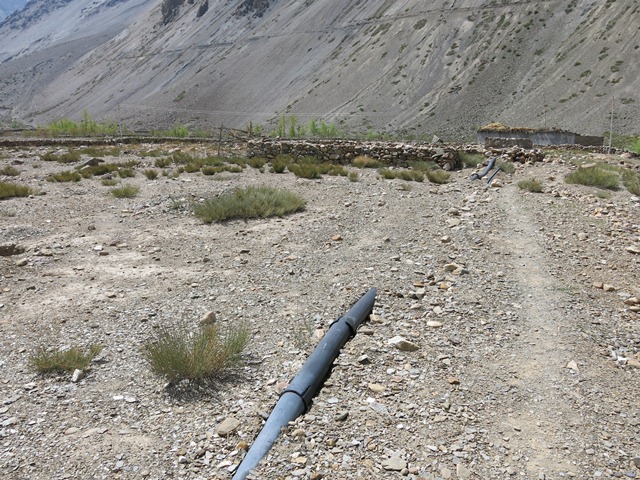
Fig. 15. An area that had many rock art boulders recently cleared for development of orchards, Sumra.
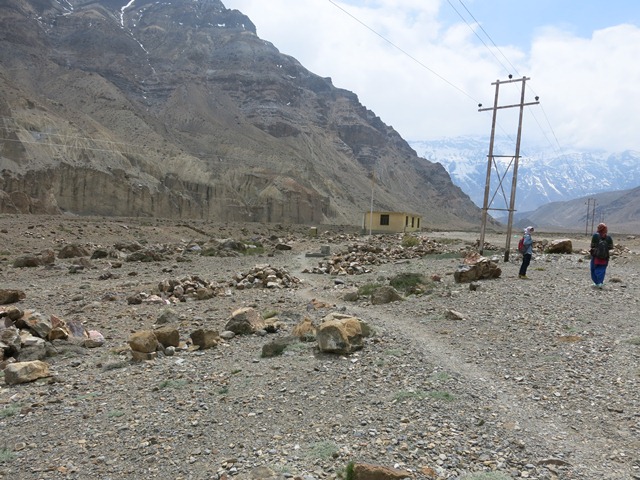
Fig. 16. An area with rock art eliminated for development projects, Poh.
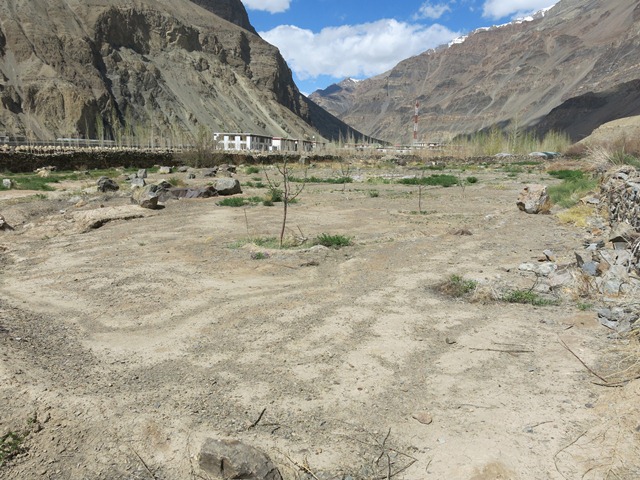
Fig. 17. An area with much rock art destroyed to make way for an apple orchard, Tabo.
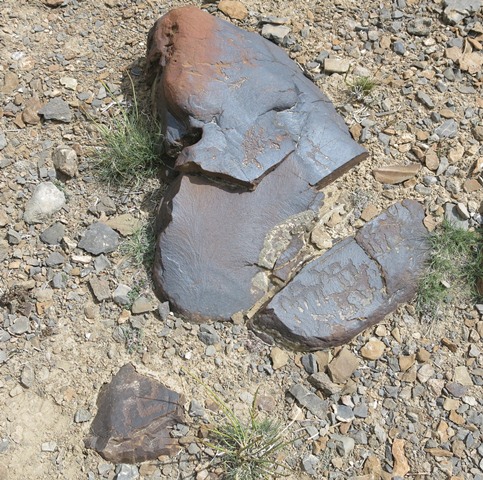
Fig. 18. A broken boulder with ancient rock art, Poh.
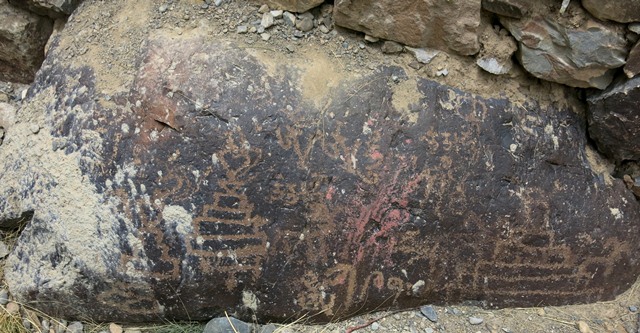
Fig. 19. A rock art boulder damaged by installation in the wall of an orchard, Tabo.
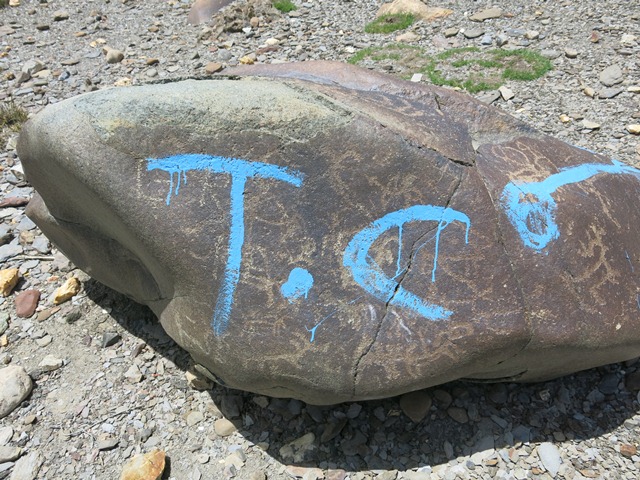
Fig. 20. Ancient rock art marked for destruction, Hurling.
Bibliography
Aas, Lars R. 2009. The Rock Carvings of Taru Thang-The Mountain Goat: a religious and social symbol of the Dardic speaking people of the Trans-Himalayas. Sarrebruck: VDM Verlag Dr. Muller Aktiengesellschaft & Co. KG.
Avner, Uzi / Kolska Horwitz, Liora / Horowitz, Wayne. Forthcoming. “The Role of Ibex Motif in the Negev Rock Art”.
Bellezza, John V. 2013. Death and Beyond in Ancient Tibet: Archaic Concepts and Practices in a Thousand-Year-Old Illuminated Funerary Manuscript and Old Tibetan Funerary Documents of Gathang Bumpa and Dunhuang. Philosophisch-Historische Klasse Denkschriften, vol. 454. Wien: Verlag der Österreichischen Akademie der Wissenschaften.
____2010. “gShen-rab Myi-bo: His life and times according to Tibet’s earliest literary sources” in Revue d’etudes tibétaines, no. 19, pp. 31–118. Paris: CNRS.
http://www.himalaya.socanth.cam.ac.uk/collections/journals/ret/pdf/ret_19_03.pdf.
____2008. Zhang Zhung: Foundations of Civilization in Tibet. A Historical and Ethnoarchaeological Study of the Monuments, Rock Art, Texts and Oral Tradition of the Ancient Tibetan Upland. Philosophisch-Historische Klasse Denkschriften, vol. 368. Wien: Verlag der Österreichischen Akademie der Wissenschaften.
____2005. Calling Down the Gods: Spirit-Mediums, Sacred Mountains and Related Bon Textual Traditions in Upper Tibet, Tibetan Studies Library, vol. 8,Leiden: Brill.
____2002a. Antiquities of Upper Tibet: An Inventory of Pre-Buddhist Archaeological Sites on the High Plateau, Delhi: Adroit.
____2002b. “Gods, Hunting and Society: Animals in the Ancient Cave Paintings of Celestial Lake in Northern Tibet” in East and West, vol.52 (1–4), pp. 347–396. Rome: IsMEO.
____2001. Antiquities of Northern Tibet: Archaeological Discoveries on the High Plateau, Delhi: Adroit.
____2000. “Bon Rock Paintings at gNam mtsho: Glimpses of the Ancient Religion of Northern Tibet” in Rock Art Research, vol. 17 (1), pp. 35–55. Melbourne.
____1999. “A Preliminary Archaeological Survey of Da rog mtsho” in The Tibet Journal, vol. 24 (no. 1), pp. 56–90. Dharamsala: Library of Tibetan Works and Archives.
____1998. “Thogchags: Talismans of Tibet” in Arts of Asia, vol. 28 (3), pp. 44–64. Hong Kong.
____1997. Divine Dyads: Ancient Civilization in Tibet, Dharamsala: LTWA.
Bruneau, Laurianne. 2013. “L’art rupestre du Ladakh et ses liens avec l’Asie centrale protohistorique”, in Cahiers d’Asie Centrale – Archéologie française en Asie centrale post-soviétique: un enjeu sociopolitique et culturel (ed. Bendezu-Sarmiento), pp. 487–498. Tashkent: IFEAC, Tashkent.
____2011a. “Influence of the Indian cultural area in Ladakh in the 1st millennium AD: the rock inscriptions evidence”, in Puratattva – The Bulletin of the Indian Archaeological Society, no. 41, pp. 179–190.
____2011b. Bruneau, L. / Devers, Q. / Vernier, M. “Rock art research in Murgi Tokpo, Nubra valley in Ladakh”, Purakala – The Journal of the Rock Art Society of India, no. 20-21, pp. 91–98.
____2010. “Le Ladakh (état de Jammu et Cachemire, Inde) de l’Âge du Bronze à l’introduction du Bouddhisme : une étude de l’art rupestre, vols. 1, 2, 3. Répertoire des pétroglyphes du Ladakh”. Ph.D. dissertation, Université Paris I-Panthéon-Sorbonne.
Bruneau, Laurianne and Bellezza John V. “The Rock Art of Upper Tibet and Ladakh: Inner Asian cultural adaptation, regional differentiation and the ‘Western Tibetan Plateau Style’” in Revue d’etudes tibétaines, vol. 28, pp. 5–161. Paris: CNRS.
http://himalaya.socanth.cam.ac.uk/collections/journals/ret/pdf/ret_28.pdf
Bruneau, L. and Vernier, M. 2010. “Animal style of the steppes in Ladakh: a presentation of newly discovered petroglyphs”, in Pictures in Transformation : Rock art Researches between Central Asia and the Subcontinent (L. M. Olivieri et al.), pp. 27–36. Orford: BAR International Series 2167. Oxford: Archaeopress.
Bunker, Emma, C. (with contributions by James C. Y. Watt and Zhixin Sun). 2002. Nomadic Art from the Eastern Eurasian Steppes: The Eugene V. Thaw and Other New York Collections. New York: Met Publications.
Chauhan, Hari / Dowad Michael / Tsering Norbu. 2014. “Spiti Valley – A Preliminary Archaeological Investigation”, in Manimahesh: A Journal of Himalayan Studies, vol. 5, pp. 24–31. Shimla: Himachal State Museum.
Chayet Anne. 1994: Art et archéologie du Tibet. Manuels d’archéologie d’Extrême-Orient, Civilisations de l’Himalaya. Paris: Picard.
Chen Zhao Fu. 2006: Zhongguo yanhua quanji – Xibu yanhua (1) (The Complete Works of Chinese Rock Art – Western Rock Art Volume 1), vol. 2. Shenyang: Liaoning meishu chubanshe.
De Terra, Helmut. 1940. “Felsbilder sprechen”, in Durch Urwelten am Indus Erlebniffe und Forschungen in Ladak, Kashmir und im Pandschab, pp. 41–48. Leipzig: Brodhaus.
Dotson, Brandon. 2013. “The Princess and the Yak: The Hunt as Narrative Trope and Historical Reality, in Scribes, Texts, and Rituals in Early Tibet and Dunhuang. Proceedings of the Third Old Tibetan Studies Panel held at the Seminar of the International Association for Tibetan Studies, Vancouver 2010 (eds. B.
Dotson, K. Iwao, and T. Takeuchi), pp. 61–85. Contributions to Tibetan Studies, vol. 9. Wiesbaden: Ludwig Reichert Verlag.
http://www.kingship.indologie.uni-muenchen.de/_assets/articles/dotson_2013_princess.pdf
Francfort, Henri-Paul / Klodzinski, Daniel / Mascle, George. 1992. “Archaic Petroglyphs of Ladakh and Zanskar”, in Rock Art in the Old World: papers presented in Symposium A of the AURA Congress, Darwin (Australia), 1988 (ed. M. Lorblanchet), pp. 147–192. New Delhi: Indira Gandhi National Centre for the Arts.
____1990: “Pétroglyphes archaïques du Ladakh et du Zanskar”, in Arts Asiatiques, vol. 45, pp. 5–27. Paris
Francke, August H. 1914. Antiquities of Indian Tibet. Part 1, Personal Narrative. Reprint, Delhi: Archaeological Survey of India, New Imperial Series, vol. 38., S. Chand, 1994.
____1903. “Some more rock-carvings from Lower Ladakh”, in Indian Antiquary, vol. 32, pp. 361–362. Bombay.
____1902. “Notes on rock-carvings from Lower Ladakh”, in Indian Antiquary, vol. 31, pp. 398-401. Bombay.
Handa, O. C. 2001. Buddhist Western Himalaya. Part 1 – A Politico-Religious History. New Delhi: Indus Publishing House.
Hauptmann, Harald. 2007. “Pre-Islamic Heritage in the Northern Areas of Pakistan”, in Karakoram: Hidden Treasures in the Northern Areas of Pakistan (ed. S. Bianca). Turin: Umberto Allemandi & Co.
http://archnet.org/system/publications/contents/4868/original/DPC1581.pdf?1384787065
Huber, Toni. 2005: “Antelope Hunting in Northern Tibet: Cultural Adaptations to Wildlife Behaviour”, in Wildlife and Plants in Traditional and Modern Tibet: Conceptions, Exploitation, and Conversation (eds. A. Boesi & F. Cardi), pp. 5–17. Memorie della Societa italiana di Scienze Naturali e del Museo Civico di Storia naturale di Milano, vol. 33.
http://www.cwru.edu/affil/tibet/booksAndPapers/Antilope.hunting.in.northern.Tibet.pdf
Jettmar, Karl. 1988. “Petroglyphs as Evidence for Religious Configurations?”, in: Journal of Asian Civilizations, vol. 31, pp. 65–146.
http://archiv.ub.uni-heidelberg.de/propylaeumdok/1725/1/Jettmar_Petroglyphs_2008.pdf
Klimburg-Salter, Deborah. 1990. “Tucci Himalayan Archives Report, 1. The 1984 Expedition to the Western Himalayas, and a Retrospective View of the 1933 Tucci Expedition”, in East and West, vol. 40 (nos. 1–4), pp. 145–171. IsMEO.
Jacobson-Tepfer, Esther and Meacham, J. E. 2009: Archaeology and Landscape in the Altai Mountains of Mongolia. Online publication: University of Oregon Department of Art History. http://img.uoregon.edu/mongolian/index.php
Li Yongxian, 2004: “Zhada pendi yanhua de faxian ji dui Xizang yanhua de jidian renshi” (“The Discoveries of Rock Painting in Zhada Basin and Some Ideas on Tibetan Rock Painting”), in Xizang kaogu yu yishu guoji xueshu taolunhui lunwenji (Essays on the International Conference on Tibetan Archaeology and Art) (eds. Huo Wei and Li Yongxian), pp. 30–46. Chengdu: Sichuan renmin chubanshe.
Mani B. R., 1998: “Rock Carvings and Engravings in Ladakh: New Discoveries”, Pragdhara vol. 9, pp. 65–74.
Martin, Dan. 2001. Unearthing Bon Treasures: Life and Contested Legacy of a Tibetan Scripture Revealer, with a General Bibliography of Bon. Leiden: Brill.
Mock, John. “New Discoveries of Rock Art in Afghanistan’s Wakhan Corridor and Pamir: A Preliminary Study” in The Silk Road, vol. 11
http://www.silkroadfoundation.org/newsletter/vol11/SilkRoad_11_2013_mock.pdf
Nautiyal, Vinod et al. (six authors). 2014. “Lippa and Kanam: Trans-Himalayan cist burial culture and pyrotechnology in Kinnaur, Himachal Pradesh, India”, in Antiquity,vol. 88 (no. 339).
Norbu, Namkhai, C. 2009. The Light of Kailash: A History of Zhang Zhung and Tibet, vol. 1. Merigar: Shang Shung Publications.
Olivieri, Luca M. 2011. “Painted Rock Shelters of the Swat-Malakand Area From Bronze Age to Buddhism: Materials for a Tentative Reconstruction of the Religious and Cultural Stratigraphy of Ancient Swat”. Ph.D. dissertation, Freien Universität Berlin.
http://www.diss.fu-berlin.de/diss/servlets/MCRFileNodeServlet/FUDISS_derivate_000000012499/OLIVIERI_L_M_Thesis.pdf
Peissel, Michel. 1984. The Ant’s Gold: Discovering the Greek Eldorado. London: Collins-Harvill.
Pirie, Fernanda. 2008 “Dancing in the face of death: Losar celebrations in Photoksar” in Modern Ladakh: Anthropological Perspectives on Continuity and Change (eds. M. van Beek and F. Pirie), pp. 175–193. Brill Tibetan Studies Library, vol. 20. Leiden: Brill.
Pohle, Perdita. 2000. Historisch-Geographische Untersuchungen im Tibetischen Himalaya. Giessener Geographische Schriften, Heft 761. Texts. Giessen: Selbstverlag des Instituts für Geographie der Justus-Liebig Universität.
Suolang Wangdui (Bsod-nams dbang’-dus). 1994. Art of Tibetan Rock Paintings. Chengdu: Sichuan People’s Publishing House.
Thakur, Laxman, S. 2008. “Bonpos of the Western Himalayas”, in South Asian Studies, vol. 24 (no. 1), pp. 27–36.
____2001. Buddhism in the Western Himalaya: A Study of Tabo Monastery. Delhi: Oxford University Press.
Thsangspa, Tashi Ldawa. 2014. “Ancient Petroglyphs of Ladakh: New Discoveries and Documentation” in Art and Architecture in Ladakh: Cross-cultural Transmissions in the Himalayas and Karakorum, pp. 15–34. Leiden: Brill.
____N.d. Petroglyphs of Ladakh: The Withering Monuments http://www.tibetheritagefund.org/media/download/petroglyphs.pdf
Tucci, Giuseppe. 1935. “On Some Bronze Objects Discovered in Western Tibet”, in Artibus Asiae, vol. 5. (no. 2/4), pp. 105–116. Zurich: Artibus Asiae Publishers.
____(in collaboration with E. Ghersi). 1936. Shrines of a Thousand Buddhas: Exploring for Tibet’s Hidden Art. New York: Robert M. McBride & Co. Reprint, Varanasi: Pilgrims, 2008.
Vernier, Martin. N.d. Exploration et Documentation des pétroglyphes du Ladakh, 1996-2006. Fondation Sierre: Carlo Leone et Mariena Montandon.
Vohra, Rohit. 1989. The Religion of the Dards of Ladakh: Investigations into their Archaic ’Brog-pa Traditions. Ettelbruck: Skydie Brown.
